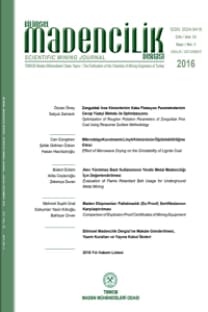OLİVİNİN REFRAKTER HAMMADDESİ OLARAK KULLANIMI İÇİN DEMİR İÇERİĞİNİN MANYETİK AYIRMA İLE AZALTILMASI
REDUCTION OF IRON CONTENT BY MAGNETIC SEPARATION FOR OLIVINE USE AS A REFRACTORY RAW MATERIAL
___
- Acar, İ., 2020. Sintering Properties of Olivine and Its Utilization Potential as A Refractory Raw Material: Mineralogical and Microstructural Investigations. Ceramics International, 46 (18, Part A), 28025-28034.
- Barzegar Bafrooei, H., Ebadzadeh, T., Majidian, H., 2014. Microwave Synthesis and Sintering of Forsterite Nanopowder Produced by High Energy Ball Milling. Ceramics International, 40 (2), 2869-2876.
- Biedermann, A. R., Pettke, T., Reusser, E., Hirt, A. M., 2014. Anisotropy of Magnetic Susceptibility in Natural Olivine Single Crystals. Geochemistry, Geophysics, Geosystems, 15 (7), 3051-3065.
- Canbay, M., Kurtuluş, C., 2008. Armutlu Yarımadası’nda Manyetik Duyarlık Çalışmaları. Uygulamalı Yerbilimleri Dergisi, 7 (1), 60-64.
- Çolak, M., Oyman, T., Altun, İ. A., Pişkin, Ö., 2004. Refractory Olivine Bricks Application from the Ağla- Köyceğiz (Turkey) Dunite. Key Engineering Materials, 264-268, 1799-1802.
- Dlugogorski, B. Z., Balucan, R. D., 2014. Dehydroxylation of Serpentine Minerals: Implications for Mineral Carbonation. Renewable and Sustainable Energy Reviews, 31, 353-367.
- Ferre, E., Martin, F., 2004. Magnetic Properties of Natural and Synthetic Olivines: High-field Measurements. American Geophysical Union (AGU) Fall Meeting.
- Furlani, E., Aneggi, E., Leitenburg, C. D., Trovarelli, A., Maschio, S., 2015. Sintering Behaviour of Olivine– Ceria Blends. Ceramics International, 41 (5, Part A), 6293-6298.
- Hacıfazlıoğlu, H., 2011. Manyetik Ayırmadaki Son Gelişmeler ve Alternatif Manyetik Ayırıcı Tiplerinin Tanıtılması. İstanbul Yerbilimleri Dergisi, 24 (1), 75- 93.
- Hacıoğlu, S. (2010). Kayseri Pınarbaşı Kromitlerinin Kuru Zenginleştirilmesi. Yüksek Lisans Tezi, İstanbul Teknik Üniversitesi, İstanbul.
- Hossain, S. K. S., Mathur, L., Singh, P., Majhi, M. R., 2017. Preparation of Forsterite Refractory Using Highly Abundant Amorphous Rice Husk Silica for Thermal Insulation. Journal of Asian Ceramic Societies, 5 (2), 82-87.
- Khattab, R. M., Wahsh, M. M. S., Khalil, N. M., 2015. Ceramic Compositions Based on Nano Forsterite/ Nano Magnesium Aluminate Spinel Powders. Materials Chemistry and Physics, 166, 82-86.
- Kıdıman, F. B., 2009. Düşük tenörlü krom cevherlerinin zenginleştirilmesinin araştırılması. Yüksek Lisans Tezi, Çukurova Üniversitesi, Adana.
- Küçükoğlu, Ö., 2016. Yerli Olivin Cevherinden Refrakter Malzemeye Uygun Hammadde Üretimi. Yüksek Lisans Tezi, İstanbul Teknik Üniversitesi, İstanbul.
- Michel, R., Ammar, M. R., Poirier, J., Simon, P., 2013. Phase Transformation Characterization of Olivine Subjected to High Temperature in Air. Ceramics International, 39 (5), 5287-5294.
- Nemat, S., Ramezani, A., Emami, S. M., 2016. Possible Use of Waste Serpentine from Abdasht Chromite Mines into the Refractory and Ceramic Industries. Ceramics International, 42 (16), 18479-18483.
- Örgün, Y., Erarslan, C., 2012. 21. Yüzyılda Olivin ve Türkiye’nin Olivin Potansiyeli. Madencilik Türkiye, 23, 62-74.
- Qafoku, O., Ilton, E. S., Bowden, M. E., Kovarik, L., Zhang, X., Kukkadapu, R. K., Loring, J. S., 2018. Synthesis of Nanometer-Sized Fayalite and Magnesium-Iron (II) Mixture Olivines. Journal of Colloid and Interface Science, 515, 129-138.
- ISSN: 2564-7024
- Yayın Aralığı: Yılda 4 Sayı
- Yayıncı: TMMOB Maden Mühendisleri Odası
YERALTI MADENLERİNDE MADEN ARITMA SIRASINDA MASOVİK MADENCİLİK UYGULAMASI
OLİVİNİN REFRAKTER HAMMADDESİ OLARAK KULLANIMI İÇİN DEMİR İÇERİĞİNİN MANYETİK AYIRMA İLE AZALTILMASI
Ş.beste AYDIN, Ceyda OĞUZ, Alim GÜL
ENRICHMENT OF LOW GRADE MAGNETITE ORE BY MAGNETIC AND GRAVITY SEPARATIONS: EFFECT OF PARTICLE SIZE
Hikmet SİS, Tekin KARAAĞAÇ, Mustafa BİRİNCİ, Tufan KIYAK
Hikmet Sis, Tekin Karaağaç, Mustafa Birinci, Tufan Kıyak
KUYUMCULUK KÖKENLİ ARTIKLARDAN ALTIN VE GÜMÜŞÜN GERİ KAZANIMI
Tülin ULUCAN, Mustafa ÖZER, Hüseyin BAŞTÜRKCÜ, Fırat BURAT
BAKIR İÇEREN SİYANÜR LİÇİ ÇÖZELTİLERİNDEN ALTININ SEÇİMLİ OLARAK KAZANIMINDA ADSORBANLARIN ETKİNLİĞİ
Deus Albert MSUMANGE, Ersin Y. YAZICI, Oktay CELEP, Hacı DEVECİ
DÜŞÜK KALİTE KUVARS KUMLARININ FLOTASYON VE OKSALİK ASİT LİÇİ İLE ZENGİNLEŞTİRİLMESİ
